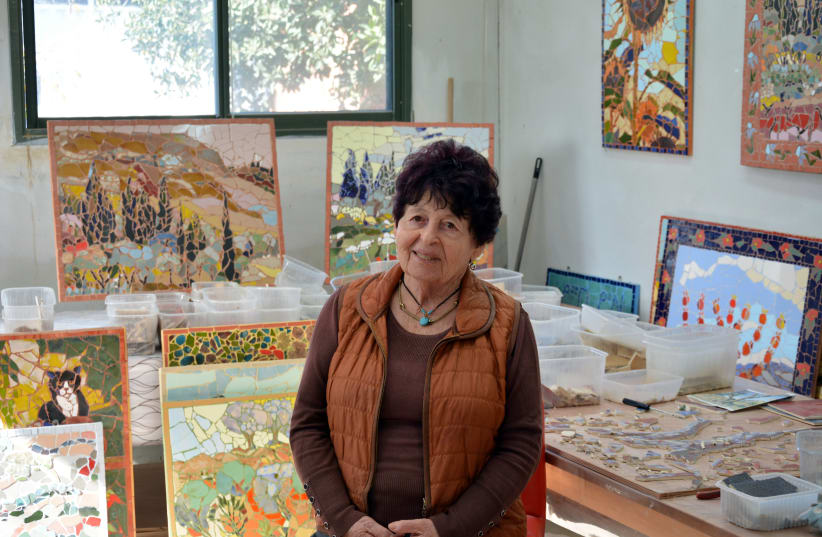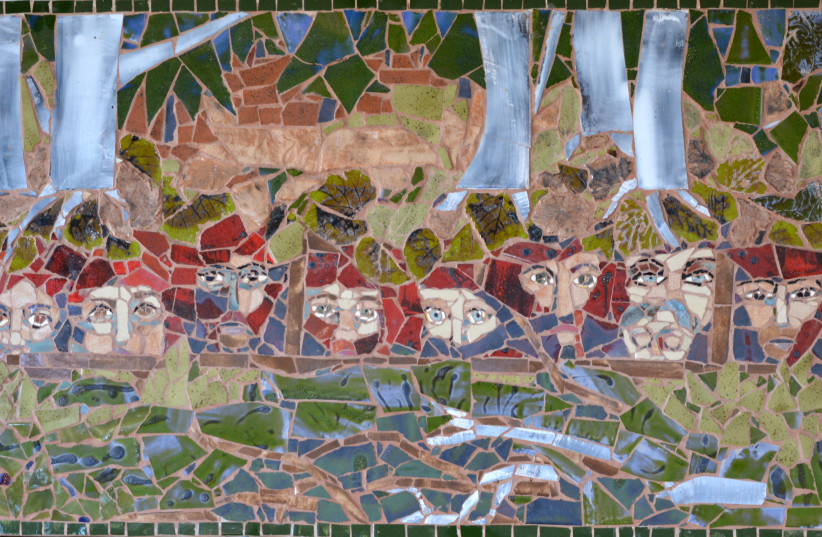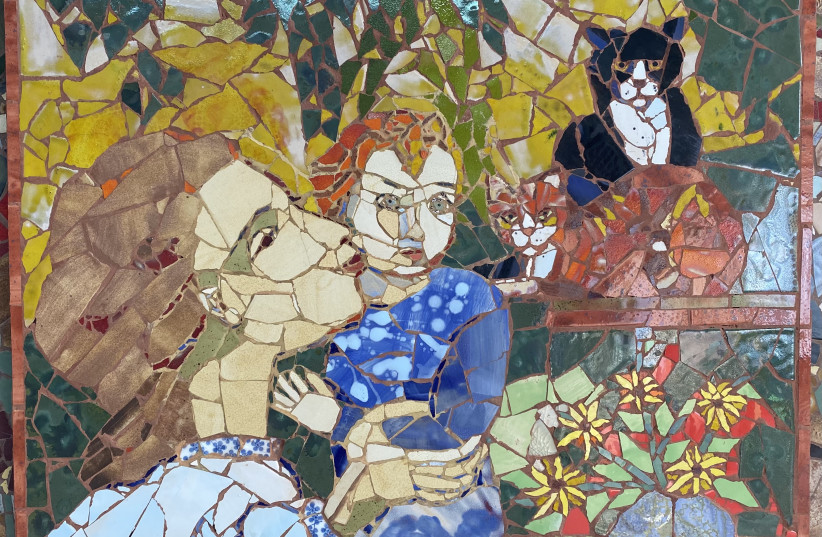The Joy of Myriam Bober’s life is written in stone, and, through the cracks, so is the pain. With infinite patience, she breaks thousands of them, colorful, smooth, to create the mosaic of her life.
Her solo exhibition, “Dance of Stone,” which extends through February 26 in the Tribal Art-Israeli Art Gallery in Tel Aviv, depicts the biblical, sun-drenched landscape of her home in Moshav Lachish in the northern Negev, where she and her husband cultivate grapes in their 50-dunam (50,000 square meters) vineyard.
“The archaeological site of the nearby Tel Lachish influences my work,” she says in a telephone interview. “I feel connected to a landscape that hasn’t changed since ancient times.”
What could be more biblical than sitting under your own vine creating mosaics in a land where archeologists unearth ancient ones? Just last April they discovered a colorful, 1,600-year-old mosaic that may have been part of a Byzantine-era mansion near the town of Yavne.
But the olive trees, the hills at sunset, the cypress, the squills, are a world away from the bleak landscape of Bober’s birth.
She was born in Lida, then Poland, in 1938, not a fortuitous time for a Jewish child to come into the world. At age three her parents, Elie and Wiga Krigel, hid in the forest in what is today Belarus.
“In that area there were partisans, and my parents hid in a bunker,” she says. “Locals found them and demanded money. My parents didn’t have any, so they murdered them.”
Bober created a mosaic forest where people are hiding or are buried. Only their eyes peek through the brush.
Prior to escaping to the forest, her parents placed her in the home of a local farmer, and she was moved from home to home. At the war’s end, friends of her parents who knew her hiding place came to fetch her. Since they planned to immigrate to the United States, they placed the six-year-old in the Helenowek Jewish orphanage in Lodz.
“I feel like it was a different incarnation, that it doesn’t belong to my day-to-day life, like a prehistoric period,” says Bober.
She tries to sidestep the snare of childhood memories.
“To this day I keep the lid closed because the memories could take over, and I don’t want to get to that point,” she says. “I am careful.”
In another work she depicts a woman sitting in a pose similar to Mary holding the dead body of Jesus in Michelangelo’s The Pieta. In Bober’s work, the mother sits on the sidewalk of a cobble-stoned street, burning buildings behind her, and holding the limp body of her dead daughter on her lap.
The mother is Perla Hoffman, who lost her daughter, Sabina, in the Warsaw Ghetto Uprising.
After the war, Hoffman visited the Jewish orphanage in Lodz to bring the children sweets. She wanted a girl and little Myriam caught her eye. Occasionally she took Myriam for ice cream. One day she took her and never brought her back. The two left Poland, spent two years in Germany, and settled in Paris.
In 1948, when Israel was established, Hoffman gave the 10-year-old Myriam a choice: come with her to Spain, or go to Israel. Myriam chose Israel. She joined a group of Jewish orphans who had been smuggled out of Poland to Paris by Lena Kuchler-Silberman, who later gained fame for her book, My Hundred Children. Kuchler-Silberman brought her young charges, Myriam included, to Israel, where they found a home in the Kvutzat Shiller kibbutz in central Israel. Myriam’s husband, Alexander Bober, was one of these children.
Bober works in her studio, a former chicken coop that she renovated 10 years ago. At the time the space seemed large, but now, with some 200 mosaics leaning one over the other against the walls, it has grown cramped.
Bober’s art echoes post-impressionism painted in stone with the same sensitivity to the effects of light and a gorgeous eye for color. Inspired by Vincent Van Gogh, she works in her own unique style, free and associative. Due to the planes of the color of the stones, the works are reminiscent of Paul Cezanne, who attempted to reduce nature to geometric essentials.
Her portraits of girls and women are full of expression, remarkable given they were created in stone.
“I can spend hours moving the stones around to create the expression in the eyes,” Bober says.
One gets the sense that behind each mosaic is a story that she tells with the tiles she creates herself. Since mosaic tiles were not available in the colors she wanted, Bober began creating her own, glazing them with brilliant colors and firing them in a kiln. Using pliers, she then cuts the tiles into uneven shapes.
Making mosaics is hard, tedious work, transforming a puzzle into art. In the past, Bober worked with oil paints and collages.
“I found that the collages fade over time, but the stones never fade,” she says.
It began with a mosaic table she made for her terrace, and evolved from hobby to art.
In the ancient world, mosaic was a medium regarded as equal to a fresco or oil painting. The oldest found to date is from the third millennium BCE in a temple in Mesopotamia. Highly durable, mosaic was used to decorate floors or walls of religious structures, secular buildings, and wealthy residences. Possibly due to the unconventional nature of the materials, to those unfamiliar with either its range or history, mosaic may be relegated to craft.
In Bober’s case, it is unmistakably art.
Her works tread carefully on the edge of memories and search to touch beauty as if saying: I was there. I have seen. I understand. Now I create with mosaic stones because the stones have always been here, as has the landscape, and so it will always remain, this beauty of orchards, of Tel Lachish, the olive trees and the cypresses. ■
Tribal & Israel Art Gallery,13 Merkaz Ba’alei Melaha Street, Tel AvivWednesday, Thursday 11:00-19:00Friday 10:00-14:00


